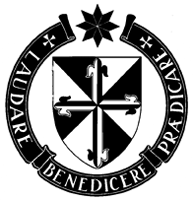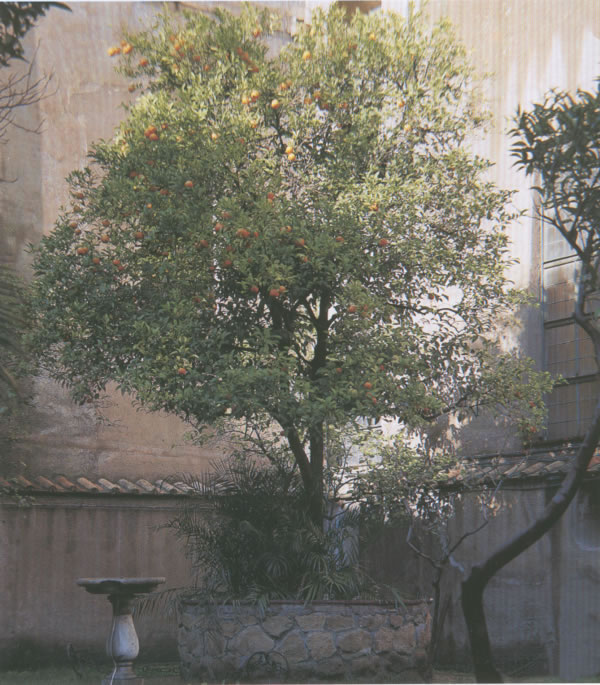|
Traditions & Symbols of the Dominican Order
Catholic artistic tradition
assigns each saint particular symbols that denote the Saint's martyrdom,
miracles, or circumstances of their lives. These symbols serve to identify the
saints, and aids to memory of a Saint's life and actions, and as symbols of
spiritual ideals.
Veritas - truth, is the motto of the Order
St Dominic, founder of the Dominican
order, is pictured with symbols from his childh ood.
A dog bearing a torch refers to his mother's prenatal dream; a star or cornona
of light was said to have appeared on his forehead at his baptism. A loaf of
bread he sometimes carries recalls a story of a miraculous supper, served to
Dominic and his starving monks by angels. ood.
A dog bearing a torch refers to his mother's prenatal dream; a star or cornona
of light was said to have appeared on his forehead at his baptism. A loaf of
bread he sometimes carries recalls a story of a miraculous supper, served to
Dominic and his starving monks by angels.
 The
other two most commonly quoted are
laudare, benedicere, praedicare (to praise, to bless, to preach)
and contemplare et contemplata aliis
tradere (to contemplate and hand on to others the fruits of
contemplation). The
other two most commonly quoted are
laudare, benedicere, praedicare (to praise, to bless, to preach)
and contemplare et contemplata aliis
tradere (to contemplate and hand on to others the fruits of
contemplation).
The Orange Tree
The orange tree pictured is at Santa
Sabina and is said to be a direct descendant of the one planted in Rome by Our
holy Father Dominic in 1220. Apparently this was the first of its type to be
planted in Italy. The Villa Sciarra in Rome has an orange grove grown in
commemoration of the bringing of the plant to Italy by St. Dominic.
SPND - appended to a
Dominican's name as in
God bless, in SPND,
Sanctus Pater Noster Dominicus =
SPND = Our Holy Father Dominic
"To contemplate and to give
to others the fruits of contemplation."
 St.
Thomas' defense of that revolution in understanding and practice gave rise to
the motto of the Order
- contemplata aliis tradere. Or to give it its fuller expression, contemplare et
contemplata aliis
tradere. Since the turn of the last century, that phrase has been often
translated as "to contemplate and to give to others the fruits of
contemplation." What we contemplate, as Dominicans, is Truth - with a capital T
- Divine Truth. And it is that Truth which we have encountered in contemplation
that we hand on to others through our preaching and teaching and other ministry.
William Hinnebusch pointed out long ago in this regard that the simply word
"Truth" does not merely point to the object of our collective vision and
mission, but expresses exactly what we mean by "contemplation." St.
Thomas' defense of that revolution in understanding and practice gave rise to
the motto of the Order
- contemplata aliis tradere. Or to give it its fuller expression, contemplare et
contemplata aliis
tradere. Since the turn of the last century, that phrase has been often
translated as "to contemplate and to give to others the fruits of
contemplation." What we contemplate, as Dominicans, is Truth - with a capital T
- Divine Truth. And it is that Truth which we have encountered in contemplation
that we hand on to others through our preaching and teaching and other ministry.
William Hinnebusch pointed out long ago in this regard that the simply word
"Truth" does not merely point to the object of our collective vision and
mission, but expresses exactly what we mean by "contemplation."
St Dominic -
images of St. Dominic
are very common in Latin countries. Usually you will be able to identify them
easily by these attributes:
Dog with Torch - According to the Golden Legend St. Dominic's mother while
pregnant dreamed that she would give birth to a dog who would hold a torch in
its mouth and would "burn the world." It has been suggested that the dog
represents a pun on Dominicanus, the word for a Dominican friar, and domini
canis, "dog of the Lord." At any rate, a dog is often shown at the saint's feet
holding a torch in its mouth, as at left.
Star on Forehead - The Legend also relates that when St. Dominic was a baby
his godmother saw a star on his forehead during the baptism, so another common
attribute is a star either on the forehead or above the head (example).
Rosary - In the above example St. Dominic also carries a rosary, which a
legend starting in the 15th century claimed had been given him by the Virgin
Mary.
Lilies - Yet another attribute is a lily or stalk of lilies, referring to St.
Dominic's notable chastity (example).
Book and Staff - Finally, we often see St. Dominic with a book and a staff
(example), a reference to a vision recounted in the Golden Legend in which Peter
and Paul give him these items and urge him to take them into the world and
preach. (In the sculpture at left, the position of the outstretched right hand
seems to suggest that originally it held a staff.)
A given image may use any combination of these six attributes, in addition to
the saint's tonsure and black-and-white Dominican habit. Sometimes, when the
context has established who the figure is, the habit and tonsure may be the only
attributes.
"Bury me under the feet of my brothers" - spoken by St Dominic at his death.
- His friars had taken Dominic to a local Benedictine abbey, where they hoped he
might rest more comfortably. Since death was approaching, the Benedictine
superior intimated that he would be very pleased to bury Dominic in the abbey;
the holy man would be given a prominent grave that would accommodate the
numerous pilgrims who could be expected to visit his final resting place. When
he caught wind of this, however, Dominic ordered his friars to take him home to
their own priory. There, after his death, they were to place his body in an
unmarked grave beneath the flooring of the house. “Bury me under the feet of my
brothers,” he commanded them.
Medieval Sourcebook: The Golden Legend: St. Dominic
Dominican
Shield Art
|
 ood.
A dog bearing a torch refers to his mother's prenatal dream; a star or cornona
of light was said to have appeared on his forehead at his baptism. A loaf of
bread he sometimes carries recalls a story of a miraculous supper, served to
Dominic and his starving monks by angels.
ood.
A dog bearing a torch refers to his mother's prenatal dream; a star or cornona
of light was said to have appeared on his forehead at his baptism. A loaf of
bread he sometimes carries recalls a story of a miraculous supper, served to
Dominic and his starving monks by angels.  The
other two most commonly quoted are
The
other two most commonly quoted are 
